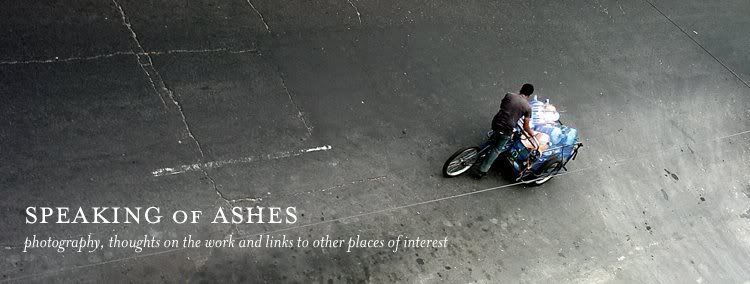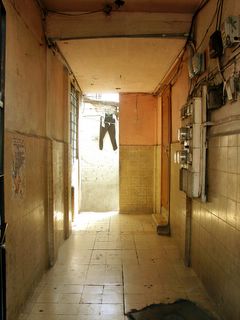
Nov 4 - Dec 16, 2005
Ampersand International Arts
1001 Tennessee Street, at 20th
San Francisco, CA 94107
Onto the scrap heap of Neo-Con ideas, may I suggest we include also the idea of art as entertainment? We won’t need to struggle with vague concepts and pretentious platitudes to understand Rebecca Szeto’s work, but indeed, it is work for us as well. Among the central tenets of modernism that we are leaving behind is the idea of art merely for art’s sake and Szeto’s is work that provides one of many paths into a world that both embraces its past and works towards redeeming its future.
The work we are looking at is alive with a creative nutrient that is feeding off of the still standing bones of a twentieth century that will not fall down, not in our life-times. And we may hate the fact that our stone monuments are thin these days and that we can only cover them, and we can’t erect new monuments in the holes we’ve dug, the holes we realize are only shadows. Szeto’s work is about realizing that interpretation, while always dependent on that which is being interpreted, is also about re-interpreting anew. It is about the fallacy of the grand concepts of yesterday (‘originality’), and her work lays groundwork for re-interpreting, and understanding re-interpretation as an on-going and always new process. She confronts the big names of Clement Greenburg and Richard Meier and the Modernist project and breaks it down into so many pieces.
I can’t count the number of times I’ve been struck by the faces on these odd steel-wool sheep. Szeto began working with the steel wool as a way of 3-dimensional-izing drawing and attracted considerable attention by virtue of the incredible level of detail she was able to achieve. The sheep have developed over a number of years and artists’ residencies into a commentary on group-thinking, and Herd Mentality. Due to the delicacy of the material, they remain tentative in their judgment. The message is one that changes with each installation, as do the sheep themselves, (this is the third installation), and it is this uncertainty that shores up the message and further diminishes our instinct to seek out Modernism’s badly stumbling shepherds.
I have no problem reading an individual personality into each or any of these seemingly uniform sheep, though with each installation they’ve become a little distorted. But are they just going along with the crowd? Is each of them thinking the same thing? Is everyone at this show going to smirk that we’ve gotten the clever point the artist intended for us? Cleverness is a trick that not particularly talented artists frequently use as an impediment to deeper thinking. Happily, there are not easy answers here. These sheep are closer to Warhol’s floating "Silver Cloud" Mylar balloons, but without the slant towards the night-life and care-free days of the mid-sixties. Sheep have to take into account a much bigger slice of history and humanity. We have to take into account a symbolism and iconography at least as old the first testament and we have to work out an explanation that uses words like “Judgment” and “interdependence,” because these stoic sheep know that they cannot live without us. They understand the interaction that each of us bring to them, they know that each of us has watched steel-wool fall apart on the back of the kitchen sink. From this commonality, this banality, Szeto pulls apart the fiber of everyday life, of contemporary mundane existence and sets loose a flock that mirrors and antagonizes. Part of the responsibility that comes with tearing modernism apart is the responsibility of understanding our own place in the work. That in this herd, we are each challenged with creating and witnessing beauty and that the absence of it is our own doing, understanding the sheepishness with which we face our situations and that sacrificing our quick definitions will make poetry out of cleaning materials. Understanding our reactions and the intent of the artist are both already part of the completion of the piece.
Modernism is a condition we found ourselves in, and a corner into which we painted ourselves. Artists in particular are guilty of painting an elitist corner that even we can no longer stand to be in. We are the creatures avoiding comfort. Today our corner is decorated almost entirely with the whispery thin veils of pointed un-intelligibility and smug assumptions about post-modernism being whatever we want it to be. When we work our way out of that last trap of modernism, we are going to find ourselves in a room like Cozying Up to Modernism. Szeto’s attempt is to embrace our recent modern history, to make it livable, and to soften the now seemingly silly hard edge of clean mid-century design. This is not an easy task. The fastidious knitting replicates the tedious and time consuming industry that is necessary to get our arms around a movement and an era that remains monolithic and in whose shadow we are still struggling to find light. Cozying up is one good way of doing it. Szeto ridicules, but her touch is painstaking, the result is only slightly ridiculous. The modern remains underneath a web of admittedly feminine and even grandmotherly misgiving. And it is none-the-less Modern. The Florence Knoll chairs and the Eames coffee table remain just on this side of the antique, but we see none of the European longing for purity that was so much of the Modern. No purity, no idealism, no ulitimate, no finality. We are finding out slowly how old-fashioned is the Modern, though all too often we’re unhappy with what we’ve got in its place. The reasoning seems so minor, it is all details and no totality. Cozying up to Modernism is a detail in the post-modern mosaic, and fittingly, it is a mosaic in itself. It is all the trappings of modern domesticity, the ease of living, caught up in a web of thinking.
As the sheep themselves are domesticated, so we find that grand themes of modern living are brought back into the sphere of domestic life. Szeto is concerned with comfort and DIScomfort because it is at this level of personal inquisition that the questions are being asked and, at least partly, temporarily, answered. There are no patterns, the knits are designed and carried out specifically for this furniture alone and, loop upon loop, they do more than decorate an archaic framework of thinking, they provide, in their intimacy and in their industry, a flexible and customized architecture of thought for the future. Tangles are always possible but there is comfort and at some level, there is the discomfort of knowing our domesticated way of being is always subject to change.
Mexico City
November, 2005










